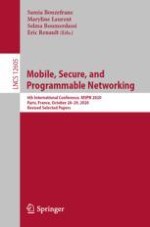2021 | Buch
Mobile, Secure, and Programmable Networking
6th International Conference, MSPN 2020, Paris, France, October 28–29, 2020, Revised Selected Papers
herausgegeben von: Dr. Samia Bouzefrane, Maryline Laurent, Selma Boumerdassi, Eric Renault
Verlag: Springer International Publishing
Buchreihe : Lecture Notes in Computer Science
